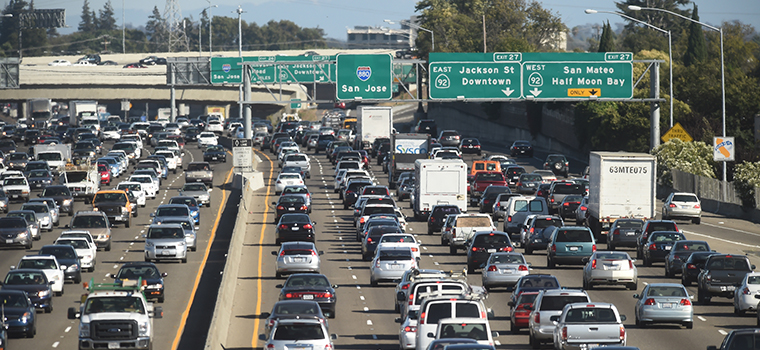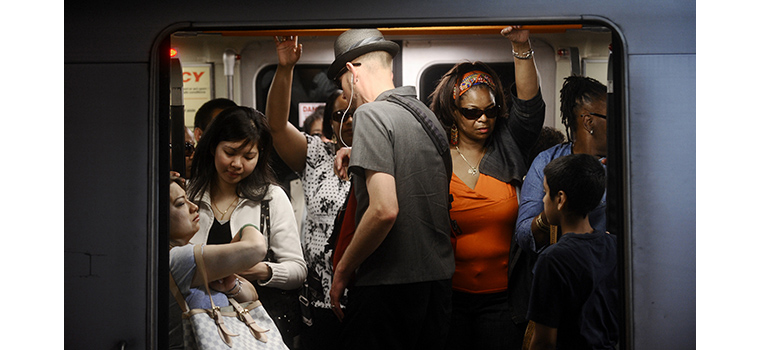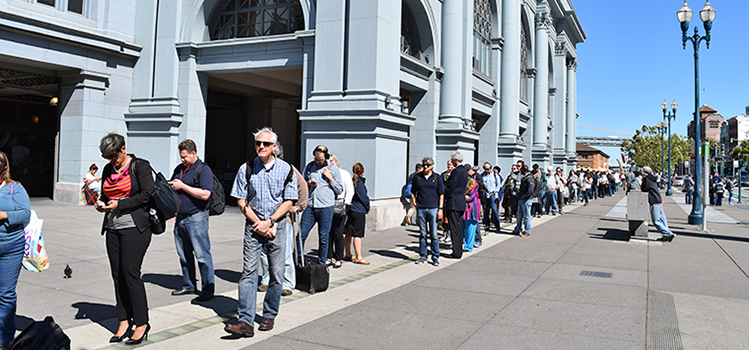Traffic in the Bay Area is worse than ever! In a recent public opinion poll, 85 percent of those asked said that traffic was worse in 2017 than in 2016.

The RM3 expenditure plan includes $500 million for new BART railcars to accommodate record ridership. Photo by Noah Berger
BY JOEL WILLIAMS
Published: February, 2018
Traffic in the Bay Area is worse than ever! In a recent public opinion poll, 85 percent of those asked said that traffic was worse in 2017 than in 2016. Traffic congestion has hit record numbers four years in a row and grown 80 percent since 2010. We often hear that this is the result of our booming economy—but without some form of relief, it is only a matter of time before the crushing congestion will negatively affect the business environment in the Bay Area.
All signs indicate that things will get worse before they get better without a major fix. The Mercury News reported in January that well over 100,000 new primary jobs will be added in Silicon Valley alone over the next decade, with more coming in the future. The report cited Apple moving 15,000 more employees into its two million square foot “spaceship” and Google building out over 10 million square feet that could house almost 50,000 new employees. The report also states that, for every primary job added, there are additional local jobs added to support the increased population.
In late January, the Bay Area Toll Authority (BATA) approved a resolution to place a sweeping $4.45 billion package of congestion relief projects known as Regional Measure 3 (RM3) on the June 5 ballot in all nine Bay Area counties. The measure would relieve congestion in the worst freeway bottlenecks, massively enhance BART, ferry and bus capacity and make transformative investments throughout the Bay Area.
If approved by a combined majority of all voters, these projects would be financed by a $1 increase in tolls on the Bay Area’s seven state-owned toll bridges beginning January 1, 2019, followed by a $1 increase in January 2022 and another $1 increase in January 2025.
The RM3 expenditure plan was developed last year by state lawmakers, with Governor Jerry Brown’s October 2017 signature on state Senate Bill 595 authorizing BATA’s action. Major projects in the RM3 expenditure plan include expansion of BART’s railcar fleet to accommodate record ridership and the system’s pending extension to Milpitas and East San Jose; further extension of BART’s Silicon Valley service to downtown San Jose and Santa Clara; extending Caltrain to downtown San Francisco; expanding transbay bus services and AC Transit’s bus rapid transit lines; constructing a direct freeway connector from northbound U.S. 101 to eastbound Interstate 580 in Marin County, and improving the westbound approach to the Richmond-San Rafael Bridge and the I-580/ Richmond Parkway interchange in Contra Costa County; constructing a direct connector between Interstates 680 and 880 in Fremont; upgrading the I-680/State Route 4 interchange in Contra Costa County, the I-680/State Route 84 interchange in Alameda County and the U.S. 101/State Route 92 interchange in San Mateo; various upgrades to relieve congestion in the Dumbarton Bridge corridor and improve State Route 37 in Marin, Sonoma, Napa and Solano counties; completing the widening of U.S. 101 to three lanes in each direction through the Marin-Sonoma Narrows; extending the new SMART rail system to Windsor; expanding San Francisco’s fleet of Muni Metro rail cars; and adding more vessels to the San Francisco Bay Ferry fleet.
RM3 also would provide $50 million for planning and preliminary engineering of a second rail tube connecting the East Bay and San Francisco; and fund a $150 million grant program to improve bicycle and pedestrian access to regional transit hubs and to close gaps in the San Francisco Bay Trail. In addition, the measure includes a provision to establish an Inspector General position to oversee BART’s capital investments.
“Nobody likes higher tolls,” said MTC Chair and Rohnert Park City Councilmember Jake Mackenzie. “But nobody likes traffic jams or crush-loaded train cars either. The Bay Area has been blessed by several consecutive years of strong economic growth. But the price we’ve paid is the growing congestion on our freeways, railways, buses and ferries. If our region is going to maintain its economic leadership, we have to invest in projects that will keep businesses and their workers moving. Governor Brown and the state legislature deserve a lot of credit for shaping RM3 into a comprehensive and integrated strategy that will modernize both our highways and our transit networks.”
Recent polling conducted in late 2017 shows that a slight majority already approve the regional traffic relief plan, with just over 40 percent opposed and roughly 7 percent undecided. However, the poll also showed that support for the measure increases significantly after potential voters learn more about the projects, with almost 60 percent approval.
For details on the complete range of investments that would be funded if a majority of voters in the nine Bay Area counties approve RM3, visit MTC’s web site at mtc.ca.gov/our-work/advocate-lead/regional-measure-3.
Bay Crossings fully supports the passage of RM3 to provide much-needed relief from the soul-crushing traffic jams that currently plague the Bay Area as well as our overcrowded public transit options. In the following months, we will provide you with more information on this vital measure. Next month, we will concentrate on the importance of RM3 to the future of Bay Area ferry service.

Long lines and passengers left behind are regular occurrences at the San Francisco Ferry Building these days. The Vallejo route is currently operating at 94 percent capacity during peak hours. RM3 will provide $300 million of new capital and up to $35 million of annual operating revenue to help rapidly build out the system, providing up to 15-minute ferry frequencies at peak times. Photo by Joel Williams


